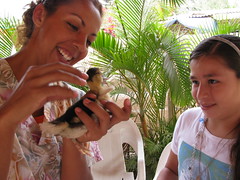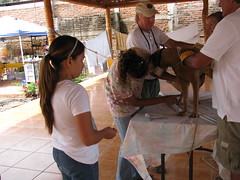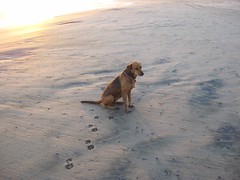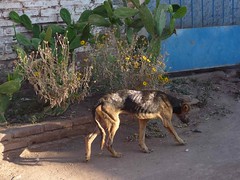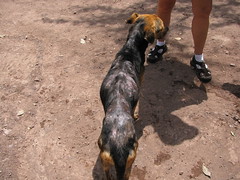Heartbreak City, for sure.
 Here's the story: A few days ago a neighbor asked if we could help with her neighbor's dog, one that she had been feeding. He was emaciated, mucous dripping from his nose, had a noticeable lack of coordination. Like a drunk.
Here's the story: A few days ago a neighbor asked if we could help with her neighbor's dog, one that she had been feeding. He was emaciated, mucous dripping from his nose, had a noticeable lack of coordination. Like a drunk.Last week we had already been busy helping animals around the village. We rescued a pitiful dachsund mutt who in one week has evolved into the lovely Princessa Mia and has stolen our hearts. And then there's the cocker spaniel that showed up at our palapa one morning, stinking and ailing with a fever. After a quick haircut and three days of antibiotic infections, she's bouncing around the town again, unfortunately noticeably pregnant. This will be her third litter in less than two years.
So the neighbors know we will help.
Last night a veterinarian made a house call to our remote little rancho of Arroyo Seco, at our request, to see if the current dog in crisis could be helped. He was still wobbling around in front of our place that morning, but when the vet showed up around 5, the dog was gone --- taken off to a remote pasture by someone in the village, whether to die or to get the dog isolated, I wasn't sure.
Our neighbor's husband hopped on his bicycle to bring the dog back so the vet could check him out --- something I definitely didn't understand because it didn't seem like the dog could walk that far. But there's a lot I don't understand here, especially when everyone's speaking in Spanish so fast that I'm catching about every 10 words --- if I'm lucky. And then there is also the cultural differences in how we care for our pets.
 Eventually we ended up with the Oscar the vet (in the red shirt) and the dog -- and a committee of about 10 --- in the same place and the immediate verdict was ––– distemper.
Eventually we ended up with the Oscar the vet (in the red shirt) and the dog -- and a committee of about 10 --- in the same place and the immediate verdict was ––– distemper.Distemper?
Good grief. Don't they vaccinate against that here?
Apparently not often.
So tomorrow we'll put the poor pooch to sleep, vaccinate his siblings and the same owner's mama dog who has four-week old puppies, plus a different neighbor's dogs who have been sharing food and water.
Later, we'll do some research, make a plan, figure out the best way to help that might really make a difference --- prevention.
When you get past the tears from watching this poor dog suffer, the anger follows. How the heck can this happen so easily in 2010? Are these people heartless? Ignorant?
I think the truest answer might be two-fold: there's no veterinarian in the village and there's no money to pay for vaccinations. It costs between $10 to $15 per shot. Might not seem a lot to someone living (and working) in the States or Canada, but it could be close to a day's wages here. It might mean the difference between food on the table, clothes for their children, gas in the car.
So we have a two-fold response to the distemper crisis: bring in the vet, provide the money for vaccinations.
Another neighbor asked me today if the vet could look at her daughter's dog whose hind legs don't seem to be working. And then there's the other dog that apparently got bitten in the neck by a snake and the neck might now be gangrene.
I know we can't rescue every dog. But there's a lot we can do. We can continue to get every pooch snipped and clipped so every dog is a wanted dog. We'll work on getting them all vaccinated. We encourage -- and maybe find a way to fund the use of a monthly tick treatment so dogs won't get Ehrlichia.
We're a small village. Sometimes it feels insurmountable. I know it's impossible to save them all. But what is possible is to help by educating, preventing, and sometimes funding.
And eventually, hopefully, it will feel less like Heartbreak City.
 The lovely Princessa Mia on the first day at home in the Palapa Pink Flamingo, Arroyo Seco. She's definitely decided to stay.
The lovely Princessa Mia on the first day at home in the Palapa Pink Flamingo, Arroyo Seco. She's definitely decided to stay.
